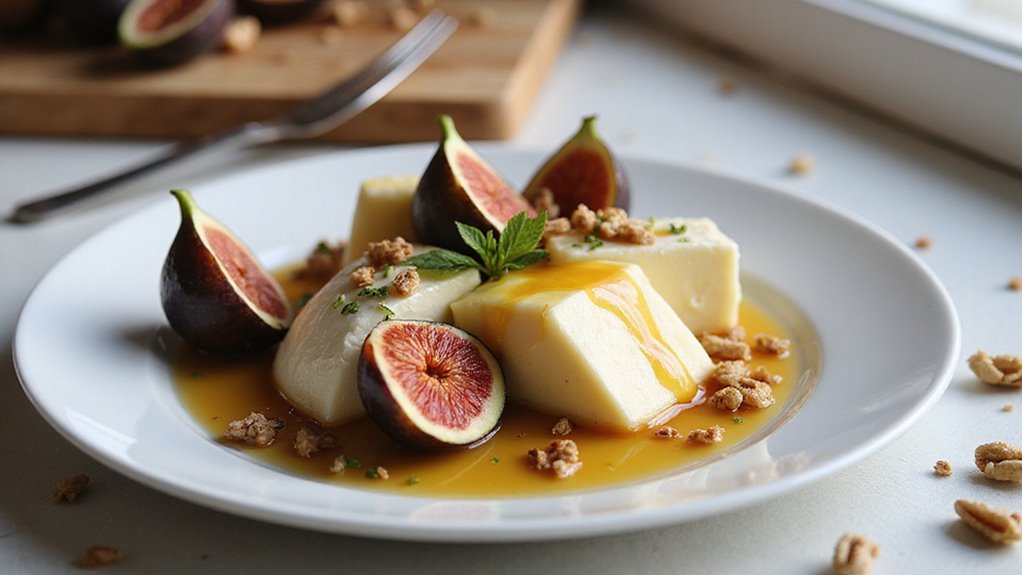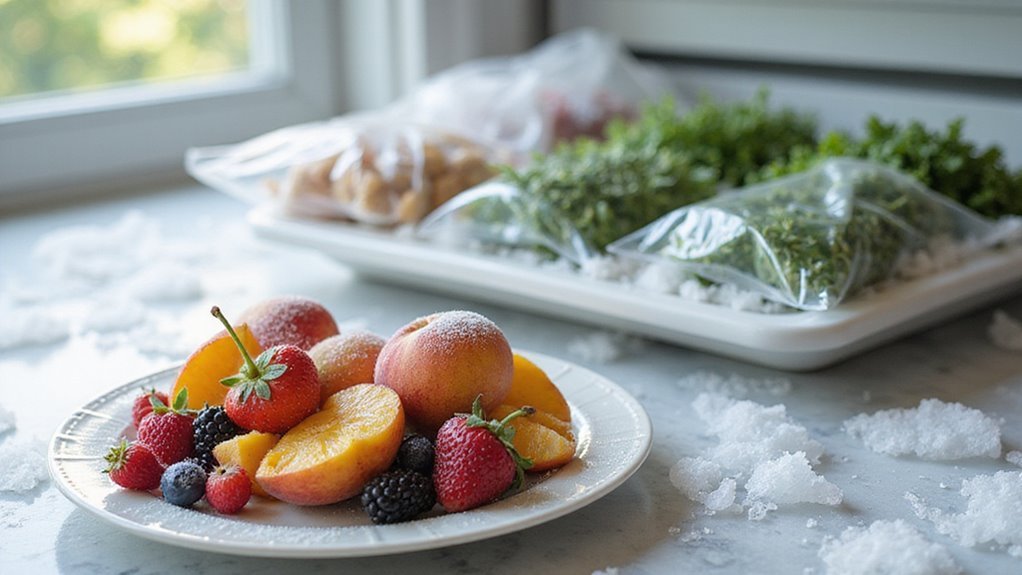Most home vacuum sealers apply far too much pressure for delicate foods like berries, baked goods, and soft cheeses – crushing them into an unappetizing mess. We’ve mastered techniques that preserve the integrity of fragile items while still achieving an airtight seal. Using strategic methods like controlled pulsing and protective barriers can mean the difference between perfectly preserved delicacies and squashed disappointment. Let’s explore the essential tactics that’ll transform your vacuum sealing game.
Understanding Delicate Foods and Their Challenges

When it comes to vacuum sealing delicate foods, we’re dealing with a unique set of challenges that’ll make or break your preservation efforts.
While vacuum sealing helps extend shelf life, delicate items like whipped cream, leafy greens, and soft fruits require special attention. Air bubbles trapped within these foods can expand during the sealing process, causing overflow or crushing.
The food preservation game changes when we’re working with brittle textures. Cookies crumble, purees overflow, and those perfectly arranged greens get squished.
It’s a battle between preserving freshness and maintaining structural integrity – one we’ll win with proper technique and understanding. Additionally, it’s crucial to be aware of safety concerns with vacuum sealing certain foods to avoid potential spoilage or contamination.
The Pulse Method for Gentle Sealing
The Pulse Method stands as one of three essential techniques for preserving delicate foods without destroying their structure.
We’ll show you how to master this game-changing approach for vacuum sealing fragile items.
Here’s the magic: You’ll start and stop the sealing process repeatedly, giving you precise control over pressure. This prevents your leafy greens from becoming mush and keeps those cookies intact.
For best results, we recommend pre-freezing delicate items before sealing.
Watch closely as you pulse – you’ll see when to stop for that perfect airtight seal. It’s especially brilliant for foamy mixtures that might otherwise overflow. Additionally, using the vacuum sealing technique not only protects delicate items but also enhances flavor infusion for a more delicious outcome.
Pre-Freezing Techniques for Fragile Items

Pre-freezing takes your vacuum sealing skills to new heights.
When
Buffer Materials and Protective Layers
Protection stands at the forefront of successful vacuum sealing for delicate items.
We’ll use buffer materials like paper towels and parchment paper to absorb pressure and moisture, preventing your leafy greens and baked goods from getting crushed.
For extra-fragile items, bubble wrap‘s your secret weapon – it’s a game-changer for cushioning delicate foods during the sealing process.
These protective layers aren’t just about preserving shape.
They’re essential guardians of flavor and texture.
By strategically placing these buffers inside vacuum bags, we’re creating a defense system that maintains food quality while ensuring proper preservation. Moreover, using high-quality vacuum packaging bags is crucial for achieving optimal results in preserving your delicate items.
Trust us – your delicates will thank you.
Manual Control and Pressure Adjustments

Mastering manual control stands as your greatest defense against crushed delicates. We’ll show you how to harness your vacuum sealer’s “Pulse” function for perfect results with fragile foods.
| Action | Purpose |
|---|---|
| Use Pulse | Control pressure manually |
| Lower Settings | Prevent food crushing |
| Monitor Process | Stop before damage |
| Short Cycles | Preserve structure |
| Small Batches | Enable precision |
When vacuum sealing delicate foods, pressure adjustments are critical. Watch for overflow and be ready to pause. Think of it like squeezing a sponge – you want to remove air without destroying the material. Start with shorter cycles and smaller portions until you’ve nailed the technique. Additionally, remember that vacuum sealing liquids can require special techniques to avoid mess and preserve quality.
Container Options for Sensitive Foods
Three essential container types will make or break your delicate food storage success.
Let’s cut through the noise and get straight to what works.
- Rigid containers – These workhorses prevent crushing and are perfect for cookies, crackers, and other brittle items.
- Vacuum seal bags with cushioning – Built-in bubble wrap or foam liners protect fragile snacks from pressure damage.
- Mason jars with vacuum lids – Ideal for herbs, spices, and delicate dried goods.
- Vacuum canisters – Your go-to for soft produce, featuring adjustable pressure controls.
To ensure longevity, always keep your jars clean and dry before sealing, as this is essential for proper sealing.
We’re not messing around here – choose the right container, and you’ll maximize shelf life while maintaining food integrity.
Temperature Considerations During Sealing
Temperature control is your secret weapon for vacuum sealing delicates without disaster.
We’ll teach you the essential temperature considerations that make or break your preservation efforts.
Let delicate foods cool to room temperature before sealing – this prevents messy overflows and seal failures.
For ultra-sensitive items like whipped cream and purees, pre-chilling or partial freezing is your best friend. It firms them up and reduces air volume.
Hot foods? Don’t even think about it. Steam buildup will wreck your seals.
Use temperature control settings on your vacuum sealer for ideal preservation, and always freeze delicate items solid before sealing. Additionally, ensure that you are aware that sealing hot food can promote bacterial growth, which can compromise food safety.
Storage Guidelines for Sealed Delicates
Now that you’ve mastered the art of sealing at the right temperature, let’s protect your vacuum-sealed treasures with proper storage.
For highly perishable items, proper storage guidelines are essential after removing air from the bag.
- Store sealed items below 32°F (0°C) in a cool, dry place to maximize freshness.
- Keep vacuum bags away from strong odors that can penetrate the seal.
- Label each bag with contents and date for proper rotation.
- Avoid direct sunlight and check seals regularly for damage.
Remember: Even the best vacuum seal won’t save your delicates without proper storage conditions. Additionally, vacuum sealing can extend shelf life significantly, ensuring your delicate items last longer.
Frequently Asked Questions
How Do I Get the Most Out of My Vacuum Seal Bags?
Surprisingly, we don’t need fancy vacuum seal techniques. Let’s simply maintain our sealing machine, choose quality bags, store them properly, and leave adequate space when preserving our items.
What Fabrics Should Not Be Vacuum Sealed?
We shouldn’t vacuum seal silk garments, wool items, lace fabrics, or anything with delicate embroidery. These materials can be damaged, trap moisture, develop mold, or lose their shape under pressure.
Is It Better to Vacuum Seal Moist or Dry?
We’ll get better results vacuum sealing dry items since moisture control can compromise sealing techniques. Dry foods offer superior food preservation and longer storage duration than moist items we’d need to pre-freeze.
What Are the Disadvantages of Vacuum Sealing Clothes?
Like Pandora’s box, we’ve found vacuum sealing drawbacks can trap moisture and odors, while air removal issues cause wrinkles. Storage limitations and potential clothing damage make this method challenging for delicates.
